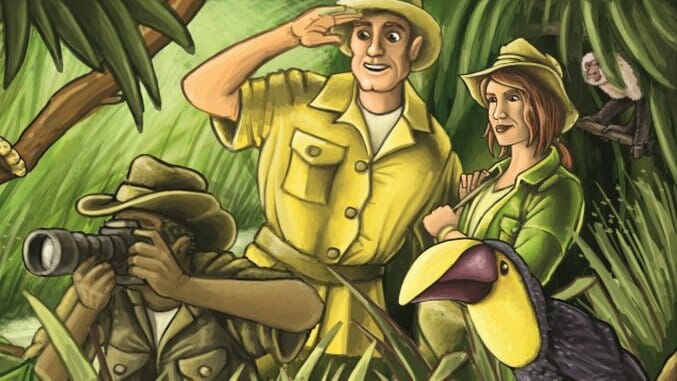Push Your Luck With the Light Boardgame Costa Rica

Costa Rica is the latest game from Matthew Dunstan and Brett Gilbert, designers of the Kennerspiel-nominated game Elysium. This time they’re aiming for the younger demographic with a rain forest-themed game of exploration that revolves around a push-your-luck mechanic. It’s light and simple to learn, but perhaps a little too simple and unbalanced for your grown-up game night.
In Costa Rica, players are explorers turning over tiles in a giant hexagonal board of 61 tiles (5 per side) that includes three tile types (forest, wetlands, mountain), each of which has one of two animal types on the hidden side. Players try to collect as many tiles as possible, earning points for each complete set of six animals (one of each) and gaining points for collecting up to seven tiles in each animal type, with the points increasing for each additional tile up to seven: 1, 3, 6, 10, 15, 21, 28. (I’m sure you can guess the next number in the sequence, but there’s no additional bonus for collecting an eighth sample of an animal type.)
Each player starts the game with six meeples, one placed at each vertex of the hexagon. Players explore the board together in “expeditions,” with one player taking the lead. The leader chooses which tiles to flip over, and after each tile is revealed, players may choose to take all of the exposed tiles and end the expedition, with the leader getting first choice and each player after the leader getting the choice to take or pass, going in clockwise order. Most tiles have just one animal on their faces; some have two of the same type, and a few have two different animals. About a third of the tiles in the game have mosquito symbols on them; these “threat” tiles are meaningless until an expedition encounters two of them, which immediately ends the expedition. The two threat tiles are discarded and all other exposed tiles on the expedition go to the leader, after which control passes to the next player.
This push-your-luck mechanic means that players are always competing against the board as well as other players, trying to figure out the odds of encountering a threat tile while also determining whether it’s a good move to take the tiles and pass control to the next player. Collecting the tiles you need to grab the 20-point bonus for a complete set—meaning one tile for each of the six animals in the game—is critical, but once you choose to take tiles and end an expedition, that meeple is out of the game and can’t collect further tiles for you.
-

-

-

-

-

-

-

-

-

-

-

-

-

-

-

-

-

-

-

-

-

-

-

-

-

-

-

-

-

-

-

-

-

-

-

-

-

-

-

-








































